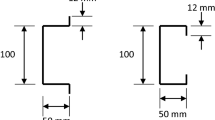Abstract
Stainless steel has been widely utilized as structural materials of building due to significant characteristics in its superior corrosion resistance, durability, aesthetic appeal etc. Recently, experimental and numerical studies of structural behaviors and curling (out-of-plane deformation) influence for single shear bolted connection fabricated with thin-walled plane plates have been performed by Kim T.S. In this paper, finite element analysis (FEA) has been conducted based on the existing test result of channel bolted connections in austenitic stainless steel. The validation of numerical approach was verified to predict the structural behaviors of bolted connections such as fracture mode, ultimate strength and curling occurrence. Curling also occurred in the channel bolted connections with a long end distance like bolted connections assembled with plane plates. The curling reduced the ultimate strength and ultimate strength reduction caused by curling has been estimated quantitatively through the strength comparison of analysis results of FEA models with free edge and restrained curling. Additional parametric analysis for FEA models with extended variables has been performed. Therefore, the ultimate strengths were compared with current design strengths and modified strength formulae for channel bolted connections considering curling effect were proposed.
Similar content being viewed by others
References
ABAQUS Ver. 6.4 (2003). Analysis User’s Manual. ABAQUS Inc., Pawtucket, 18-4, USA.
AIJ (2002). Recommendation for the design and fabrication of light weight steel structures. Architectural Institute of Japan, Tokyo, Japan.
AISC (2001). Manual of Steel Construction-Load and Resistance Factor Design. American Institute of Steel Construction, Chicago, IL, USA.
AISC (2011). Steel construction manual. American Institute of Steel Construction, Chicago, IL, USA.
AISI S100-10 (2010). North American specification for the design of cold-formed steel structural members. American Iron and Steel Institute, Washington D.C., USA.
AS/NZS 4673 (2001). Cold-formed stainless steel structures. AS/NZS 4673, Australian Standard/New Zealand Standard Australia, Australia.
SEI/ASCE-8-02 (2002). Specification for the design of coldformed stainless steel structural members. American Society of Civil Engineers, USA.
Bedair, O. (2011). “Serviceability and ultimate limit states of channels under compression and bi-axial bending.” Journal of Constructional Steel Research, 67(10), pp. 1415–1425.
Chu, X., Kettle, R., and Li, L. Y. (2004). “Lateral-torsion buckling analysis of partial-laterally restrained thinwalled channel-section beams.” Journal of Constructional Steel Research, 60(8), pp. 1159–1175.
EC 3 (2006). Eurocode 3: Design of steel structures: supplementary rules for stainless steels.-Part 1.4. London, European Committee for Standardization, UK.
Epstein, H. I. (1992). “An experimental study of block shear failure of angles in tension.” AISC Engineering Journal, 29, pp. 75–84.
HKS (1998). ABAQUS Theory Manual Ver.5.8., Hibbitt, Karlsson & Sorensen Inc. Pawtucket, USA.
JIS G 4321 (2010). Stainless Steel for Building Structure. Japan Industrial Standards, Tokyo, Japan.
JIS Z 2241 (2010). Method of Tensile Test for Metallic Materials. Japan Industrial Standards, Tokyo, Japan.
Kim, T. S. and Kuwamura, H. (2007). “Finite element modeling of bolted connections in thin-walled stainless steel plates under static shear.” Thin-Walled Structures, 45, pp. 407–421.
Kim, T. S. and Kuwamura, H. (2011). “Numerical investigation on strength design and curling effect of mechanically fastened joints in cold-formed austenitic stainless steel.” Materials and Design, 32, pp. 3942–3956.
Kim, T. S. and Lim, J. H. (2013). “Ultimate strength of single shear two-bolted connections with austenitic stainless steel.” International Journal of Steel Structures, 13, pp. 1–12.
Kim, T. S., Jeong, H. Y., and Cho, T. J. (2011a). “The finite element analysis of the ultimate behavior of thin-walled carbon steel bolted connections.” Journal of Constructional Steel Research, 67, pp. 1086–1095.
Kim, T. S., Kim, M. S., Kim, S. H., and Lee, Y. T. (2013). “A numerical study on block shear strength of channel bolted connections fabricated with austenitic stainless steel.” Advanced Materials Research, 680, pp. 247–251.
Kim, T. S., Kim, M. S., Kim, S. H., Lee, Y. T., and Shin, S. W. (2011b). “Block shear behaviours of stainless steel channel bolted joints with four bolts.” Advanced Materials Research, 255–260, pp. 74–78.
Kim, T. S., Kuwamura, H., and Cho, T. J. (2008). “A parametric study on ultimate strength of single shear bolted connections with curling.” Thin-Walled Structures, 46, pp. 38–53.
Kim, T. S., Kuwamura, H., Kim, S. H., and Cho, T. J. (2009). “Investigation on ultimate strength of thin-walled steel single shear bolted connections with two bolts using finite element analysis.” Thin-Walled Structures, 47, pp. 1191–1202.
Kuwamura, H. and Isozaki, A. (2002). “Ultimate behavior of fastener connections of thin stainless steel plates.” Journal of Structural and Constructional Engineering, Transactions of Architectural Institute of Japan, 556, pp. 159–166.
Orbison, J. G. and Ziemian, R. D. (1995). “Assessment of American block shear load capacity predictions.” Journal of Constructional Steel Research, 359, pp. 323–338.
Orbison, J. G., Wagner, M. E., and Fritz, W. P. (1999). “Tension plane behavior in single-row bolted connections subject to block shear.” Journal of Constructional Steel Research, 49, pp. 225–239.
Pan, C. L. (2004). “Prediction of the strength of bolted coldformed channel sections in tension.” Thin-Walled Structures, 42, pp. 1177–1198.
Author information
Authors and Affiliations
Corresponding author
Rights and permissions
About this article
Cite this article
Kim, T., Kim, M. & Cho, T. Strength of channel bolted connection with austenitic stainless steel (304 type). Int J Steel Struct 15, 719–731 (2015). https://doi.org/10.1007/s13296-015-9017-3
Received:
Accepted:
Published:
Issue Date:
DOI: https://doi.org/10.1007/s13296-015-9017-3



